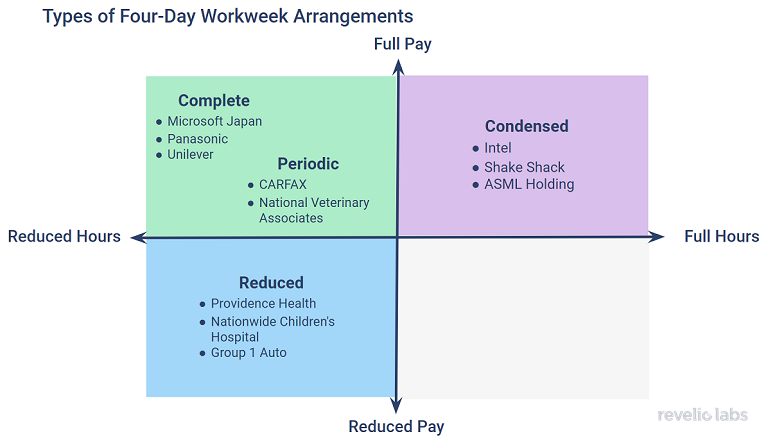Four-Day Workweek [Terms and Conditions Apply]
The four-day workweek is a hit, but there’s a catch
![Four-Day Workweek [Terms and Conditions Apply]](https://cdn.sanity.io/images/btz0doeh/production/372c5143be6e5ab487c1cc2b3c1a368b07d795b6-1280x720.jpg?rect=1,0,1278,720&w=600&h=338&auto=format)
The four-day workweek has seen a sharp rise and subsequent fall in popularity among employers over the past three years.
Job postings mentioning a four-day workweek get filled 35% faster than those that don’t.
In practice, there are many different versions of the four-day workweek policy. In many workplaces advertising one, hours are reduced, but employers expect output to remain unchanged.
The four-day workweek has been a hot topic lately, and for good reason: Three-day weekends every week admittedly sound nice. But how are employers offering it, and is it really all it’s cracked up to be? We have answers.
To understand the prevalence of the four-day workweek, Revelio Labs can look at mentions of the policy in US job posting descriptions. We can see in our workforce intelligence that it gained popularity rapidly in 2021, when the Great Resignation saw employers experimenting with new ways to attract talent. However, it has begun falling off over the past year.


What have experimenting employers found? If finding new talent faster has been one of the goals of offering four-day workweeks, the policy seems to work. Using our workforce intelligence to compare job openings within the same industry and role, we find that those that offer a four-day workweek as a perk get filled 13 days faster than jobs with a standard workweek—a time save of over 35% on average.


But four-day workweeks are not all alike. On the surface, the idea behind the policy seems simple: You work four days, you rest three. On closer inspection, however, its implementation can differ drastically from workplace to workplace. Here are the most common versions that Revelio Labs has come across:
1. Complete four-day workweek
The most well-known form of the four-day workweek, also known as “100-80-100.” Compensation is unchanged (100%). Employees work four days a week, for eight hours a day, totaling 32 hours per week (80%). But here’s the catch: Output is also expected to remain the same (100%). This implies a productivity increase of 20%!
2. Reduced four-day workweek
Employees work four days a week, for 32 hours total, but they are only paid for those 32 hours. In other words, they receive 80% of the pay.
Sign up for our newsletter
Our weekly data driven newsletter provides in-depth analysis of workforce trends and news, delivered straight to your inbox!
3. Seasonal / Periodic four-day workweek
The complete version of the four-day workweek but confined to every two weeks or once a month, or during the summer months only.
4. Condensed-Schedule four-day workweek
In this version, total work hours are not reduced, but instead 40 work hours are condensed into four days.
Each arrangement sets some level of pay and some reduction in hours. The figure below shows where each policy falls, along with a few of the companies offering it.

The four-day workweek is still new; in the future, we will be looking to explore how the policy affects employee mental health and well-being. For now, when you see the words “four-day workweek,” just be sure to check the fine print.

